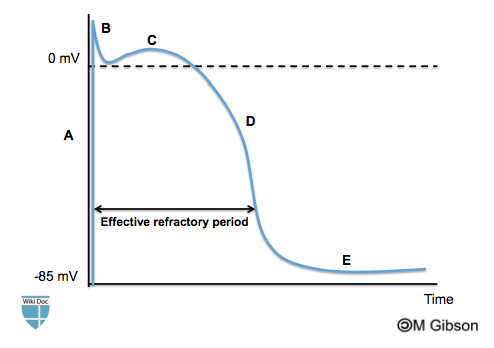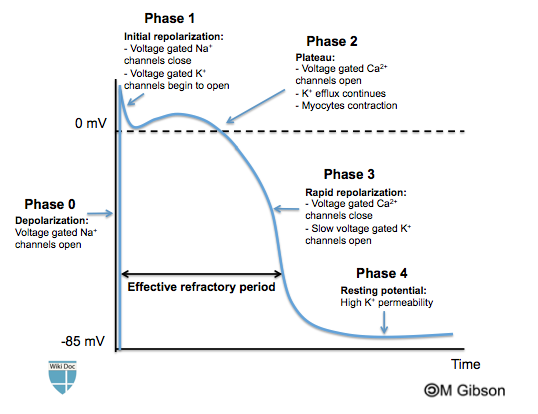WBR1016: Difference between revisions
No edit summary |
No edit summary |
||
| Line 46: | Line 46: | ||
|AnswerEExp=E corresponds to phase 4 of the [[ventricular action potential]]. Phase 4 is characterized by a [[resting potential]] which is caused by the high potassium permeability through the potassium channels. Quinidine affects phase 0 of the ventricular action potential. | |AnswerEExp=E corresponds to phase 4 of the [[ventricular action potential]]. Phase 4 is characterized by a [[resting potential]] which is caused by the high potassium permeability through the potassium channels. Quinidine affects phase 0 of the ventricular action potential. | ||
|EducationalObjectives=[[Quinidine]] is an antiaarhythmic acting on the voltage gated sodium channels; therefore, affecting phase 0 of the ventricular action potential. | |EducationalObjectives=[[Quinidine]] is an antiaarhythmic acting on the voltage gated sodium channels; therefore, affecting phase 0 of the ventricular action potential. | ||
|References=First | |References=First Aid 2014 page 274, 372. | ||
|RightAnswer=A | |RightAnswer=A | ||
|WBRKeyword=Quinidine, Cardiac action potential, Heart, Cardiology, Antiarrhythmic | |WBRKeyword=Quinidine, Cardiac action potential, Heart, Cardiology, Antiarrhythmic | ||
|Approved=No | |Approved=No | ||
}} | }} | ||
Revision as of 16:38, 6 September 2014
| Author | [[PageAuthor::Rim Halaby, M.D. [1]]] |
|---|---|
| Exam Type | ExamType::USMLE Step 1 |
| Main Category | MainCategory::Pharmacology |
| Sub Category | SubCategory::Cardiology |
| Prompt | [[Prompt::A 27 year old male comes for a general check up following his last visit to Africa. He is very worried about his general health because he had severe malaria during his visit requiring the use of an intravenous medication that caused him a lot of side effects such as headaches and tinnitus. The medication used to treat this patient also has antiarrhythmic effect. Which of the following labelled phases of the ventricular action potential is affected by the medication used to treat malaria? |
| Answer A | AnswerA::A |
| Answer A Explanation | [[AnswerAExp::A corresponds to phase 0 of the ventricular action potential. Phase 0 is characterized by a depolarization caused by the abrupt opening of the voltage gated sodium channel. Quinidine is an antiaarhythmic acting on the voltage gated sodium channels; therefore, affecting phase 0 of the ventricular action potential.]] |
| Answer B | AnswerB::B |
| Answer B Explanation | [[AnswerBExp::B corresponds to phase 1 of the ventricular action potential. Phase 1 is characterized by an early repolarization caused by the closure of the sodium channels and the opening of voltage gated potassium channels. Quinidine affects phase 0 of the ventricular action potential.]] |
| Answer C | AnswerC::C |
| Answer C Explanation | [[AnswerCExp::C corresponds to phase 2 of the ventricular action potential. Phase 2 is characterized by a plateau. The plateau results from the opening of the voltage gated calcium channels leading to an influx of calcium that balances the potassium efflux. Quinidine affects phase 0 of the ventricular action potential.]] |
| Answer D | AnswerD::D |
| Answer D Explanation | [[AnswerDExp::D corresponds to phase 3 of the ventricular action potential. Phase 3 is characterized by a rapid repolarization caused by the closure of the calcium channels and opening of the slow voltage gated potassium channel. Quinidine affects phase 0 of the ventricular action potential.]] |
| Answer E | AnswerE::E |
| Answer E Explanation | [[AnswerEExp::E corresponds to phase 4 of the ventricular action potential. Phase 4 is characterized by a resting potential which is caused by the high potassium permeability through the potassium channels. Quinidine affects phase 0 of the ventricular action potential.]] |
| Right Answer | RightAnswer::A |
| Explanation | [[Explanation::Intravenous quinidine is used for the treatment of severe complicated malaria. Cinchonism characterized by headaches and tinnitus is a side effect of quinidine. Quinidine is also an antiaarhythmic acting on the voltage gated sodium channels; therefore, affecting phase 0 of the ventricular action potential.
The ventricular action potential is composed of four phases:
|
| Approved | Approved::No |
| Keyword | WBRKeyword::Quinidine, WBRKeyword::Cardiac action potential, WBRKeyword::Heart, WBRKeyword::Cardiology, WBRKeyword::Antiarrhythmic |
| Linked Question | Linked:: |
| Order in Linked Questions | LinkedOrder:: |

